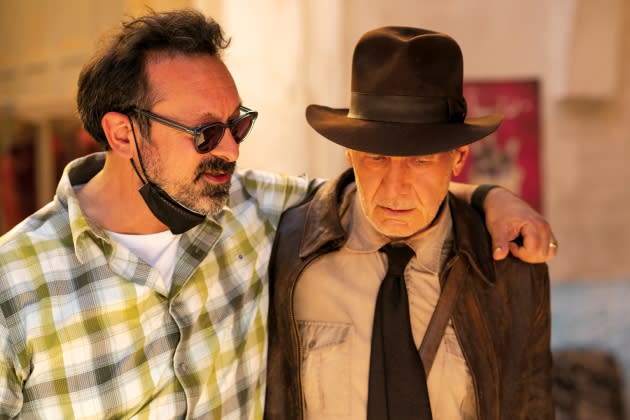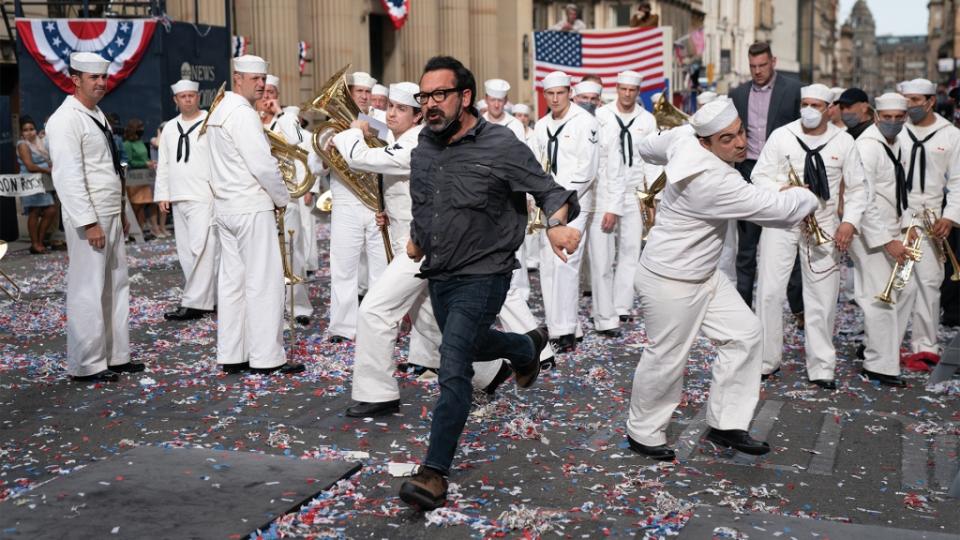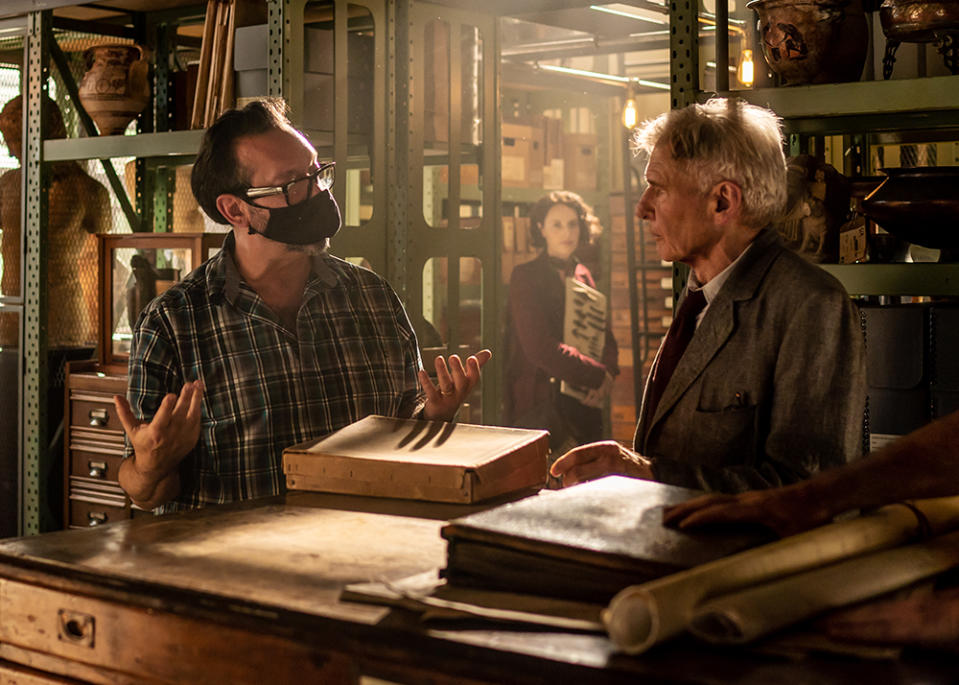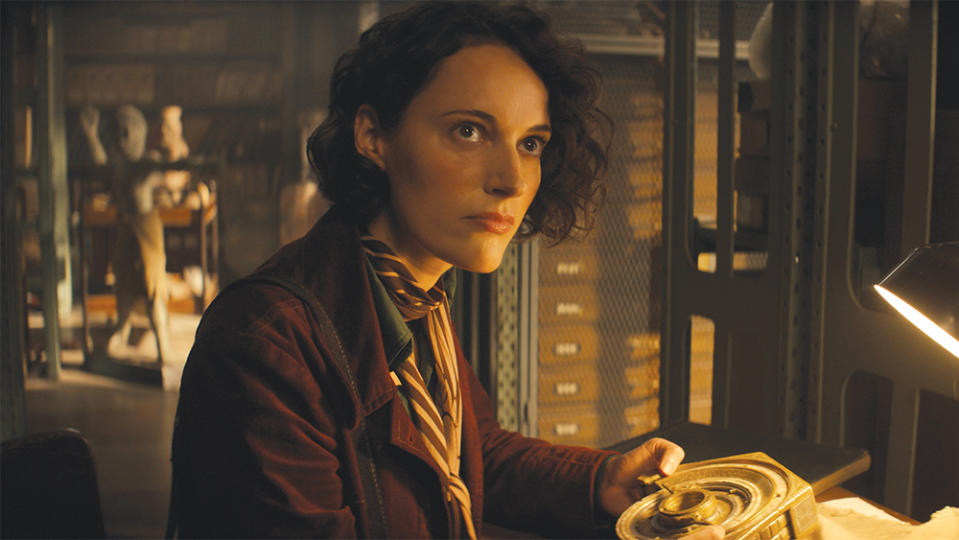‘Indiana Jones 5’ Director James Mangold on ‘Pinch-Hitting’ for Spielberg and Refusing Fan Service: Franchises Have Become ‘Large-Scale Advertising’
- Oops!Something went wrong.Please try again later.
- Oops!Something went wrong.Please try again later.
- Oops!Something went wrong.Please try again later.
- Oops!Something went wrong.Please try again later.

Before Indiana Jones entered director James Mangold’s life, Harrison Ford told him he was worried Indy was looking too old.
It was the fall of 2019, and Mangold had joined the team working on the film adaptation of “The Call of the Wild,” in which Ford plays a rugged frontiersman, to help with reshoots. In their downtime, Ford began confiding in Mangold about the fifth “Indiana Jones” movie, which had been bouncing around in development for the better part of three years. Steven Spielberg and screenwriter David Koepp had conceived a roughly five-minute opening sequence set during World War II, in which Ford would be digitally de-aged. Ford wasn’t sure it was a good idea.
More from Variety
“Harrison told me he was nervous, because he felt like if people saw him younger, when they confronted Indiana in his 70s they’d be disappointed,” Mangold says, sitting on a cream-colored couch inside his sunlit office on the Fox lot in early June.
At the time, the filmmaker had no reason to think he was auditioning to be the guy to solve Ford’s dilemma. But Mangold impressed the actor. “He seemed to have a keen perception of what was required,” Ford says. “I just found it very easy and comfortable to work with him.” So much so that when Spielberg decided later that year that it was time to bequeath Indy’s signature whip and fedora to someone else, Ford recommended Mangold.
Lucasfilm president Kathleen Kennedy, who has produced every “Indy” film since serving as Spielberg’s assistant on “Raiders of the Lost Ark,” recalls, “It was pretty much immediate that Steven said, ‘Oh, he would be fantastic. Let’s do that.’”
It’s easy to understand why. Starting with his feature debut, the 1995 Sundance hit “Heavy,” Mangold has built a career steeped in the old-school Spielbergian classicism that is embedded in the DNA of the “Indiana Jones” movies. “I’ve always been a little behind the curve of what’s happening in the moment,” Mangold says. “I mean, I made a wordless film about a fat guy in a diner when everyone else was trying to emulate Quentin — when the hot thing was clove cigarettes and rock-’n’-roll soundtracks.”
For decades, that approach has served Mangold well, as he has turned out a procession of quite disparate studio features, from the psychological drama “Girl, Interrupted” and Johnny Cash biopic “Walk the Line” to the Western thriller “3:10 to Yuma” and the historical entertainment “Ford v Ferrari.” In the 2010s, he even stepped inside the Marvel sandbox and brought a brutal humanism to the comic book adaptations “The Wolverine” and “Logan,” the highest-grossing movies in his filmography.
Increasingly, though, Mangold has been feeling out of step with the franchise-building imperatives of a modern film industry fixated on sustaining an ongoing series of interconnected movies. “I am interested in making something that works from beginning to end — to curtain,” he says. “Otherwise, I’m working on the world’s most expensive television show.”

So when Kennedy approached Mangold in late 2019 about directing the fifth and final “Indiana Jones” movie, Mangold was not an instant yes.
“Oh, he was incredibly intimidated,” Kennedy recalls with a laugh. “He was immediately excited by the potential of it, but he was very daunted by stepping into Steven’s shoes.”
Still, Mangold was captivated by what was by any measure a once-in-a-lifetime opportunity, even as he was acutely aware that it came with the singular hazards inherent in taking over a franchise that has meant so much to so many for so long. “There are a million land mines,” Mangold says. “But the idea that I would get a chance to play not just in the backyard of my heroes, but with Harrison, with Steven — it was so profoundly moving to me. How many people get a chance to make a movie with these people?”
Mangold spent a year with his “Ford v Ferrari” screenwriters Jez and John-Henry Butterworth to craft the screenplay for what would become “Indiana Jones and the Dial of Destiny.” Mangold’s goal was to make a film worthy of the iconic hero and the movie star embodying him — and, perhaps, explicate his own feelings about the world passing him by. Because while the 59-year-old filmmaker’s success has brought him into the orbit of two other marquee franchises, “Swamp Thing” for DC Studios and a new “Star Wars” movie for Lucasfilm, he remains ambivalent about being seen as a franchise filmmaker at all.
As Mangold talks with me in his office, I can’t help noticing the 22 framed index cards filling the wall just above his head, each with a handwritten rule for cinematic storytelling. For example: “Self-expression (talk without action) is BORING!” And: “What is happening NOW is not as exciting as what may or may not HAPPEN NEXT.”
All of the rules were created by the late filmmaker Alexander “Sandy” Mackendrick (“Sweet Smell of Success”), who mentored Mangold as the dean of the CalArts School of Film in the early 1980s. Mackendrick had the cards hanging in his own office, and, Mangold explains, “he would point at these different rules as he was analyzing your eight-page screenplay.”
When I ask Mangold how often he’s turned to his mentor’s directives over the course of his career, he smiles wistfully. “Every day,” he says. “I’ve lived with these all my life.”
From the office walls of my greatly missed first mentor, Alexander Mackendrick. pic.twitter.com/CKdE5i5eoN
— Mangold (@mang0ld) December 9, 2018
As we converse, I begin to grasp just how much these rules have provided Mangold with the intellectual scaffolding to build a story that feels at once exciting and emotionally connected. Take that WWII prologue that had so concerned Ford. Mangold thought it was a brilliant idea, because it tackled one of his biggest issues with 2008’s “Indiana Jones and the Kingdom of the Crystal Skull”: That film barely acknowledges that Indy is not only older but has aged out of the 1930s and ’40s era that he’s meant to embody.
“What’s so beautiful about the best of the ‘Indiana Jones’ movies is that thematically they know what they’re about,” Mangold says. “I didn’t feel like I knew what ‘Crystal Skull’ was about. He’s living in a world that has overtaken him — a world that has found new heroes in John Glenn or Elvis Presley. No one in the film is really thinking about the past; everyone’s focused on the future.”
Mangold says he “spoke plainly” about these feelings in early discussions with Spielberg and Kennedy about what he’d want to do with “Indy 5,” which he felt was at risk of making many of the same mistakes as “Crystal Skull.” The MacGuffin at the center of the early script, for example, “was just another relic with power, similar to the relics we had seen,” with no clear connection to Indy or what he was going through. So he changed it to the Antikythera, an ancient mechanical device invented, in the new script’s conception, by the Greek mathematician Archimedes to allow its user to manipulate time.
“Indy had spent his entire life exploring time,” Kennedy says. “Once Jim seized upon that as a theme, it emotionally resonated, frankly, with all of us, who have in excess of 40 years invested in this storytelling.”
Mangold also understood, however, that audiences would show up with an image of Indiana Jones in his prime fixed in their memories. So rather than cut the prologue, he expanded it to a 25-minute sequence set in 1944, when Indy encounters the Antikythera for the first time on a Nazi loot train. Effectively, Mangold wanted viewers to be disappointed by the shock of cutting from Indy as a younger man to Indy in his late 70s. “It might be a really good opening gambit for the present-tense part of the movie — that much about growing older in life is disappointing,” he says.
In spite of his trepidation, Ford applied himself to the sequence with his typical aplomb. “I tried to raise my voice into a higher register, which seemed to be appropriate for the age, and physically tried to move with all the grace and youthfulness that my old ass could muster,” he says. “I had not anticipated that the process of de-aging, if you will call it that, would be so successful.”
Neither did Mangold. The director knew Ford would need to be de-aged with a level of verisimilitude that has proven elusive to filmmakers so far. The process involved drawing from hundreds of hours of archived footage of Ford as a younger man and mapping that onto the older actor’s face. But when I ask Mangold how he ensured the technology was up to snuff before he started filming, he just shrugs. He hadn’t.
“You have to believe that they’re going to be able to do something better, but you don’t know,” he says. “Every movie is a leap of faith. People are like, ‘Can Joaquin Phoenix sing?’ And you go, ‘Yeah, absolutely. He’s incredible.’ And you don’t know. You’re just believing in the people around you delivering.”

Spielberg never told Mangold why he decided to relinquish the “Indiana Jones” director’s chair, and Mangold never asked. “I never went there,” Mangold says. “I mean, it wasn’t my business. I knew he had a personal movie he had been working on, so I assumed that he wanted to make ‘The Fabelmans.’ But I didn’t grill him about it.”
The two did talk frequently throughout the making of “The Dial of Destiny,” shot from from June 2021 to February 2022, most often about the “mechanics of things” and how an “Indy” movie should feel and move. “Steven told me, ‘Think of shooting an “Indiana Jones” movie like you’re shooting a trailer — no scene can ever last too long,’” he says.
When I ask how Mangold approached making the film his own, however, he corrects me. “I wasn’t looking to make the movie my own,” he says. “I would say I was looking to have a voice.” More than practically any other film franchise in cinema history, “Indiana Jones” is inextricably associated with one filmmaker, and Mangold had no interest in changing that.
“You don’t want me doing a knockoff Steven, but I want to be playing from the same hymnal, using the same tools,” he says. “I mean, I’m pinch-hitting for Babe Ruth. I at least have to use my own swing some of the time. But the reality is, every day I’m thinking of what he would do, how he would do it. In any way I could, I wanted to do the movie in his style. It didn’t feel threatening to me at all.”
Mangold knew comparisons were inevitable, so he wasn’t exactly shocked when the premiere of “The Dial of Destiny” at the Cannes Film Festival in May drew a muted reaction from critics. “When you’re in franchise land, it’s very hard for critical thinkers” — meaning journalists — “to overlook what I’m sure their editors want, which is this business prism of how does it rate to the other ones?” he says. “I always thought if I were second or third best to one of the greatest films of all time, I’d be good. I mean, it all vaporizes later. Either the movie will live or it won’t.”
Mangold talks about this with the kind of good-natured forbearance built up over decades in the studio trenches, so I’m surprised by how animated he gets when I bring up the future of Phoebe Waller-Bridge’s character, Helena Shaw, Indy’s goddaughter. Mangold and the Butterworths wrote Helena specifically for Waller-Bridge, seeing in her the same kind of pluck and resourcefulness that made Karen Allen’s Marion Ravenwood a perfect foil for Indy in “Raiders.” I ask if he has talked with Disney and Lucasfilm about the potential for Waller-Bridge to carry on the franchise. Mangold smiles and waves his hand dismissively.
“I’m not interested,” he says. “I refuse. I just can’t do it.” He gestures to the rules hovering just over his shoulder. “The amount of lore and Easter eggs and fan service starts to become antithetical to any of this stuff at a certain point. It isn’t storytelling anymore. It’s large-scale advertising.” (For her part, Kennedy says that while it’s “entirely possible” that a Helena Shaw movie could happen, “we’re not having any of those conversations right now. We’re just focused on finishing this with Harrison.”)

At the same time, Mangold seems resigned to the inevitability of the franchise economy. For instance, Hugh Jackman will return in 2024 as Wolverine in a Marvel Studios film with Ryan Reynolds’ Deadpool, seven years after Jackman retired the character in “Logan” — the film that earned Mangold his first Oscar nomination (for adapted screenplay). “I can’t say that there’s a part of me that doesn’t wish that we’d let it be,” he says. “But there was always going to be another Wolverine. There could be a baby Wolverine and a cartoon Wolverine. As much liquid as they can squeeze out of that rag, they’re going to try to. I don’t measure my success on a movie like ‘Logan’ with whether we ended the conversation. I ended my conversation.”
The great irony is that Mangold is attached to make a DC movie and a “Star Wars” movie — he’s just choosing not to see them that way. “While I’m sure DC views ‘Swamp Thing’ as a franchise, I would be viewing it as a very simple, clean, Gothic horror movie about this man/monster,” he says. Mangold had been “toying for years with the idea of making a kind of Frankenstein movie,” he adds, so when James Gunn and Peter Safran took the reins at DC last fall, Mangold “put in a friendly call” to suggest himself. “Just doing my own thing with this, just a standalone.”
With “Star Wars,” Mangold had “more than flirted” years earlier with making a Boba Fett movie that would have been a one-off spaghetti Western in the vein of Sergio Leone. (Lucasfilm turned it into the Disney+ series “The Book of Boba Fett” instead.) So while in production on “The Dial of Destiny,” Kennedy asked him if he was still interested in exploring a galaxy far, far away. “I said, ‘Yes, but it seems like everything you’re developing is continuing forward,’” he says. He pitched “a ‘Ten Commandments’ about the dawning of the Force,” he says. “It is basically, for fans, a kind of religion. What is it to have found this power and not even understand what it is?” Kennedy pounced.
“Jim’s pretty fast — he’s already got the basic treatment laid out in his head,” she says. Once the writers strike is over, she adds, “He has every intention of wanting to move this forward very aggressively, and we want to support that.”
Before either project goes anywhere, though, Mangold intends to begin shooting the relatively small-scale Bob Dylan biopic “A Complete Unknown” with Timothée Chalamet in August. It’s the film Mangold was working on in 2019 when Kennedy approached him about “Indy,” and he’s been itching to get back to it. But the looming prospect of an actors strike in July could scuttle the movie before it starts. If a strike goes on too long, Chalamet’s commitments to promote “Dune: Part Two” and “Wonka” in the fall and winter could prevent the film from happening. When I ask Mangold about that possibility, he grimaces.
“I get asked this question,” he says. “All we do is keep moving. Just keep trying to prep the movie and hope that the two sides will resolve things. I don’t know what else I can do.”
The only thing Mangold is certain of is that he never wants to get too comfortable making anything. “I don’t put myself in one bin in the record shop,” he says. “Is he country and western or jazz? Is he rock ’n’ roll or is he soundtracks? What the fuck is he?” He laughs. “To me, sticking within one lane, I don’t know whether I’d keep learning.”
I make note of another Mackendrick rule of cinema — and, it seems, of life — hanging just out of Mangold’s view: “Drama is EXPECTATION mingled with UNCERTAINTY.”
Best of Variety
Sign up for Variety’s Newsletter. For the latest news, follow us on Facebook, Twitter, and Instagram.

